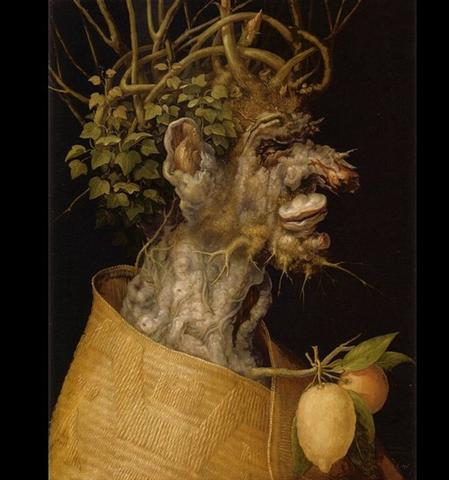Spica and Alcor rose simultaneously and they
could have kept Sky and Earth together:
... Proclus informs
us that the fox star nibbles continuously at the thong of the
yoke which holds together heaven and earth; German folklore adds
that when the fox succeeds, the world will come to its end. This
fox star is no other than Alcor, the small star g near
zeta Ursae Majoris (in India Arundati, the common wife of
the Seven Rishis, alpha-eta Ursae) ...
In the Tahitian list Spica was Ana-roto -
the star in the middle. In C the greatest vero (and the
greatest added point) was where in April 12 both Spica and
Arundathi (80 Ursae Majoris, Alcor) were seen close to the right
ascension of the Full Moon:
|
October 10 |
11 (284) |
12 |
 |
 |
 |
|
Cb8-6 (569) |
Cb8-7 |
Cb8-8 |
|
vero hia |
tagata
honui |
e ha mata |
|
Chitra-14 /
Horn-1 /
T3 |
71 Virginis
(203.6) |
Heze (205.0) |
|
SPICA, Alcor (202.7) |
|
April 12 |
13 (468) |
14 (104) |
|
no star listed |
Achernar (23.3) |
no star listed |
April
12 can be written 4-12 and then easily alluding to the night
before number 13 * 29½.
Achernar (α Eridani) was in October
11 close to the Full Moon in the night and on Easter Island it
meant spring. The previous nights were at the conjunction
between Phoenix and Toucan:

|
October 5 |
6 |
7 (280) |
8 |
9 |
 |
 |
 |
 |
 |
|
Cb8-1 (564) |
Cb8-2 |
Cb8-3 |
Cb8-4 |
Cb8-5 |
|
Hetu erua |
tagata rere
ki te ragi |
te hokohuki |
te moko |
|
ξ² Centauri
(197.9),
Apami-Atsa
(198.5) |
Diadem (198.9),
Al Dafīrah (199.4) |
σ Virginis
(200.4) |
ι Centauri
(201.4) |
Mizar (202.4) |
Sadalmelik (647) |
|
April 7 (462) |
8 |
9 |
10 (100) |
11 |
|
Revati-28 |
κ Tucanae (17.6) |
no star listed |
Ksora (20.1) |
γ Phoenicis (20.8), δ Phoenicis
(21.5) |
|
REVATI
(16.9), ν Phoenicis (17.4) |
This is the origin of the River
Eridanus, which later in early June would empty itself
at Rigel, at the mouth of the river:

|
Az Zubana 4 (200) |
5 |
6 |
|
December 2 |
3 |
4 (338) |
 |
 |
 |
|
Ca10-1 (256) |
Ca10-2 |
Ca10-3 |
|
Erua inoino |
kua hua te vai |
|
κ Ophiuchi
(256.2) |
Cujam (256.9) |
no star listed |
|
June
2 |
3 |
4 |
|
Pleione 3 |
4 |
5 |
|
no star listed |
Hassaleh (73.6) |
Almaaz (74.7),
Haedus I (74.8) |
|
Az Zubana 7 |
8 (204) |
|
9 |
10 |
|
December 5 |
6 |
7 |
8 (342) |
 |
 |
 |
 |
|
Ca10-4 |
Ca10-5 (260) |
Ca10-6 |
Ca10-7 |
| te kiore -
te inoino |
kua oho te
rima kua kai - ihe nuku hoi |
Tupu te toromiro |
kua noho te vai |
|
no star listed |
Sabik (259.7), η
Scorpii (259.9), Nodus I (260.0) |
π Herculis
(260.7), Ras Algethi (260.8), Sarin (261.0), ο Ophiuchi
(261.4) |
ξ Ophiuchi
(262.2), θ Ophiuchi, ν Serpentis (262.4) |
|
June 5 |
6 (157) |
7 |
8 (159) |
|
Pleione 6 (20) |
7 |
8 |
9 |
|
5h (76.1) |
λ Eridani (76.7) |
μ Leporis (77.6), ĸ Leporis
(78.0), Rigel (78.1), Capella (78.4) |
ο Columbae
(78.8) |
|
Haedus II (75.9), ε Leporis
(76.0), Cursa (76.4) |
|
Egyptian
eye |
 |
Phoenician ayin |
 |
Greek
omicron |
Ο(ο) |
|
... The letter name
is derived from Proto-Semitic
*‘ayn-,
eye, and the Phoenician letter had an eye-shape,
ultimately derived from the ı͗r hieroglyph
... To this day,
‘ayin in Hebrew, Arabic and
Maltese means 'eye' and 'spring' (‘ayno
in Neo-Aramaic). |
The
faint (4.81) omikron Columbae - not visible in the illustration of
Hevelius (i.e. possibly to be noted by its absence) - could have
served as a 'new year eye' close to the Full Moon in
December 8.

The
lemon form in Ca10-3 and Ca10-7 could have been an
allusion to the life-saving lemons onboard the great European
sailing ships, where such served as protection against
illness (scurvy).
"Treatment by fresh food, particularly citrus fruit, was
periodically implemented, as it had been since antiquity."
(Wikipedia)
And
perhaps the idea also motivated the fruits
hanging in front on the chest of Archimboldo's winter man - the absence
of the healthy rays from the Sun could otherwise have caused
C-vitamin shortage:

The 'fruit' (offspring) depicted inside the
hanau (birth) type of glyph in Cb8-7 could refer to
the beginning (α) of Eridanus
(Achernar). Or to night 413.
| Honui
1. Person worthy of respect, person
of authority. 2. Livelihood, heirloom,
capital; ka moe koe ki toou hônui, you must
marry to ensure your livelihood (said to a little
girl); he hônui mo taaku poki, this is the
heirloom for my son. Vanaga.
Great (hoonui); honui,
chief T.; tagata hoonui, personage;
hakahonui, to praise, to commend. Churchill.
|
|










